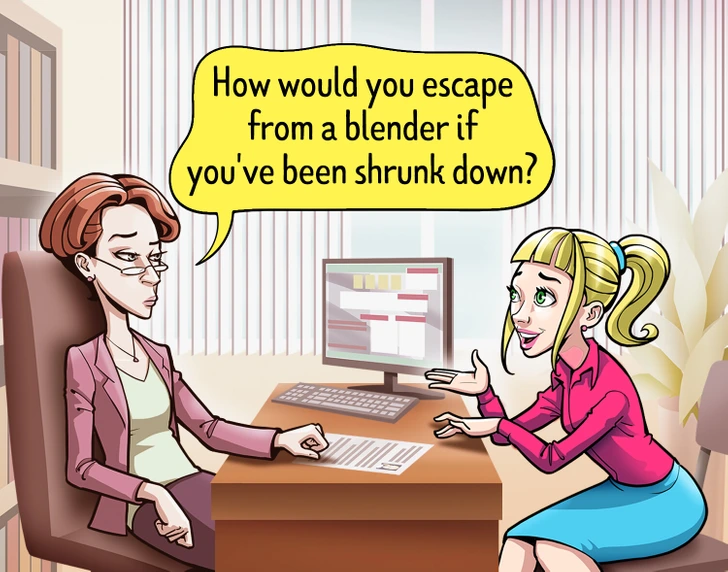Google is known for its innovative approach to hiring. Unlike traditional companies, Google doesn’t just rely on your resume to determine if you’re the right fit for the job. They use creative and often unpredictable interview questions designed to test your problem-solving abilities and how you think on your feet. Among the many unique questions they ask, one in particular has baffled many applicants: “Imagine you’ve been shrunk down to the size of a coin and placed in a tall blender. What would you do to escape before the blender turns on in 60 seconds?”
A Brain-Teaser to Test Your Reaction Time

This unusual question is one that many prospective employees have faced during their Google interviews. It’s one that challenges the way you approach a problem, focusing on creativity and logic rather than simply having the right answer. Most applicants, after a brief moment of shock, will quickly come up with a simple answer: “Just jump out.”
At first glance, jumping out of the blender might seem like a plausible solution. After all, jumping is a basic, instinctive response. The answer stems from a principle that dates back to the 17th century, thanks to the work of Alfonso Borelli, known as the father of biomechanics. Borelli noticed that animals, regardless of their size, could jump approximately the same height. This observation led to the conclusion that the size and mass of an animal didn’t directly determine how high they could jump—rather, their muscle energy was proportional to their mass.
Video:
The Google Interview Question Everyone Gets Wrong
This reasoning makes sense if you think about it: if you were smaller, you would have a stronger strength-to-weight ratio, and your muscles would be able to generate enough force to propel you upwards. So, why not just jump out of the blender?
The Problem with the “Jumping” Solution

However, as many interviewers and experts agree, the jumping answer isn’t the correct one. Here’s why: to make a successful jump, you need to transfer as much energy as possible from your legs into the ground to push yourself upwards. This transfer of energy becomes increasingly difficult as you shrink in size. The smaller you get, the more challenging it becomes to generate the necessary force.
Why? It all comes down to muscle contraction. The faster your muscles need to contract to produce enough force, the less force they can generate. This is known as the force-velocity relationship, and it’s a crucial concept in biomechanics. When you’re tiny, the muscles in your legs would have a very short amount of time to generate enough force to lift your body off the ground. Essentially, you wouldn’t have enough power to jump high enough to escape the blender.
So, while jumping seems like an instinctive answer, it’s not scientifically feasible, which leads us to seek out alternative solutions.
The Right Answer: Using a Catapult System

To solve this tricky scenario, we need to think outside the box—literally. According to Professor Gregory Sutton, a University of Lincoln expert on insect motion, the best way to escape the blender would be to use a catapult system. “If I were shrunk down and placed in a blender, I’d use a small rubber band to fling myself out,” he suggests.
This approach relies on the concept of using your strength-to-mass ratio to your advantage. Even though jumping doesn’t work well on such a small scale, the use of a catapult system would make use of the energy stored in the rubber band, releasing it to propel you out of the blender. As Professor Sutton explains, “The catapult system would work great at that size, because even if jumping doesn’t work, your strength-to-mass ratio would be ideal for using mechanical energy.”
Spring-Based Solution: Wind It Up and Release It
Another expert, Professor Jim Usherwood, who specializes in motion mechanics, proposed a slightly different solution that could also work. He suggests using a spring mechanism to escape the blender. The idea is based on a principle that has been used in archery for centuries: by storing energy in a spring, you can release that energy in an instant to create a powerful force.

“You don’t need to move your body quickly to make something go fast,” explains Usherwood. “Instead, you can slowly build up energy by winding a spring and then release it quickly.” This principle would work perfectly for our shrunken protagonist, as winding a spring and using the stored energy would allow them to be launched out of the blender.
A Real-World Example: Why the Answer Matters
While these scenarios might seem abstract, they underscore the importance of thinking critically and creatively. Google, known for its rigorous hiring process, uses these questions to evaluate how candidates approach complex problems. It’s not just about getting the “right” answer—it’s about demonstrating how well you can think through a problem, adapt to unexpected challenges, and use innovative solutions.
Video:
If You Where Shrunk To The Size Of A Nickle Trapped In A Blender What Would You Do?
For those who haven’t nailed this particular brain teaser, don’t worry. Google itself has moved away from using these types of brainteasers in interviews. Gayle Laakmann McDowell, a former Google software engineer and author of The Google Resume, revealed that Google no longer asks these types of tricky questions in their hiring process. She even pointed out that hiring managers who insist on using brain-teasers in interviews may have their feedback ignored by the hiring committee. Google now prefers to focus more on real-world problems and practical skills when evaluating candidates.
The Takeaway: Think Beyond the Obvious
At the end of the day, Google’s bizarre interview question highlights an important lesson: sometimes, the answer isn’t as obvious as it seems. In this case, the instinctive response of “jumping out” was both logical and wrong. The real answer required an understanding of physics and mechanics, along with a creative approach to the problem.
While this particular brainteaser may no longer be part of Google’s interview process, it remains an excellent example of how companies push candidates to think critically and creatively. So, the next time you’re faced with an unusual challenge, remember that the best solutions often require thinking beyond the obvious and using a bit of creativity and innovation.


